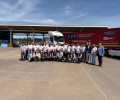RAC tests driverless vehicles
The Royal Automobile Club of Western Australia (RAC) will trial on-demand driverless and fully electric vehicles, making Perth the first city in Australia – and among the very first in the world – to test and experience this type of service.

On 29 November, RAC announced it will test – in partnership with NAVYA and the State Government – several driverless passenger ‘AUTONOM’ vehicles, which have been designed as an on-demand shared mobility service, bookable through a smartphone app.
RAC Group CEO Terry Agnew said this trial will be a significant advancement on the already ground-breaking technology in the two RAC Intellibuses, making Australians some of the first people in the world to experience the very latest in automated vehicle technology. “We must prepare for the potential impact and opportunities of driverless vehicles, as well as the changes that are required for them to safely transition on to our roads,” Mr Agnew said.
Perth is one of the first three cities globally announced as having access to these first-production vehicles, which have been developed by NAVYA. “Autonomous features like cruise control and lane detection are already available, with the industry indicating that fully driverless vehicles are now just years away, rather than a few decades,” Mr Agnew said. “Increasing levels of automation in vehicles are an inevitable part of the future, and the notion of them being in widespread use on our roads is not a question of if, but when.”
The vehicles can carry up to six passengers each, and have a maximum operating speed of 90km/hr with a likely recommended operating speed of 20 to 50km/h during the trial. The vehicles are fitted with the latest state-of-the-art multi-sensor technology, including 10 LIDARS, four radars, and six cameras, all providing the vehicles with 3D perception that allows them to map the environment, detect obstacles and make decisions which allow them to operate autonomously. The cars also feature two Global Navigation Satellite System (GNSS) antennae to determine the precise position of the vehicle at any given time, and are linked to a supervision service.
The trial, which will involve a number of stages, will take place next year with the vehicles expected to arrive in Perth in April 2018. The details of the trial are currently in development and RAC is working through the necessary approval processes with Government.

 Facebook
Facebook Twitter
Twitter






